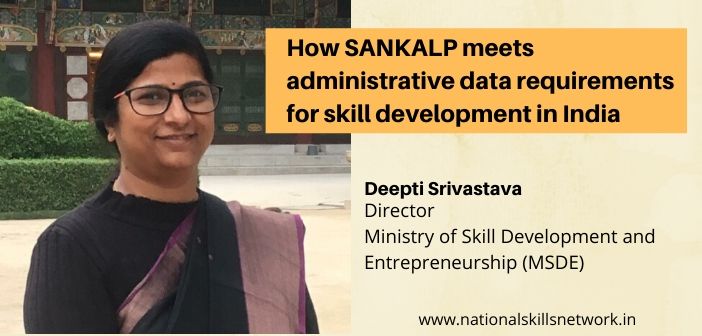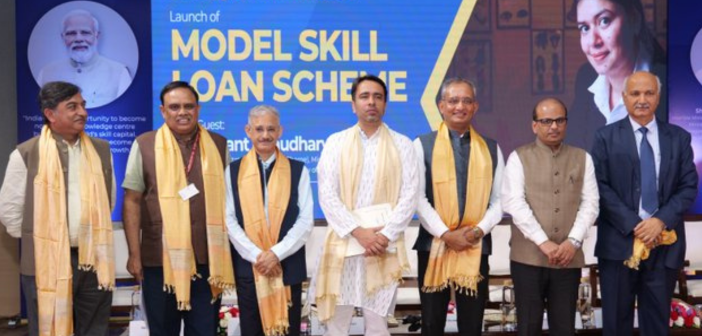In this guest article, Deepti Srivastava, Director, MSDE, explains how SANKALP meets administrative data requirements for skill development in India. The goal of SANKALP is to strengthen skill development governance at State and district levels,
The need for accurate and valid administrative data is vital and a pre-requisite for the planning and implementation of any government scheme. In India, the issue of robust administrative data was perhaps first addressed in a significant way during the implementation of schemes like Sarva Shiksha Abhiyan (SSA), Mahatma Gandhi National Rural Employment Guarantee Act (MGNREGA) and National Rural Health Mission (NRHM). During this period, various IT portals and Management Information systems (MISs) were developed for planning and implementation purpose.
Ever since, radical changes have come in the way schemes are being monitored and managed by Central and State Governments. Thereafter, the erstwhile Planning Commission made baseline survey data a mandatory and qualifying criterion for the conceptualisation and framing of any new social sector scheme.
Need for a robust Management Information systems (MIS) in the skilling sector
In the skilling sector, the need of the hour is to have a robust MIS to capitalize on the precious and abundant human resources of India. Besides few generic demographic data points such as 65% of India’s population is below the age of 35 years and construing it as an economic dividend, our policy makers do not have sufficient qualified and stratified data about the various dimensions of demand and supply which can form the basis for creating vision, mission and realistic goals for Skill India programmes.
Even basic aspects around skill development like trade opportunities, identifying industry needs with regard to skilled manpower, availability of training infrastructure, alignment of skill development schemes vis-a-vis the aspirations of youth etc. are not adequately addressed.
Due to lack of data based insights, some of the most difficult conundrums for the policy makers today is to estimate the number of people migrating from poorer states to industrialised states for seeking blue collar jobs, the trades or areas in which they work, the kind of capabilities they have, their earning levels and a plethora of other dimensions which are essential for planning and implementation of policies.
The recent issue of migrant labourers due to Covid-19 pandemic outbreak perhaps could have been handled more efficiently had our administrators possessed the latest skill sector employment data mapped to each district/town of India.
Related article: District Skill Toolkit: A major initiative towards empowering District Skill Committees (DSCs) through a standard framework – Read more: https://nationalskillsnetwork.in/district-skill-toolkit-a-major-initiative-towards-empowering-district-skill-committees-dscs-through-a-standard-framework/
 Interventions from Ministry of Skill Development and Entrepreneurship (MSDE) to creating and consolidating accurate administrative data
Interventions from Ministry of Skill Development and Entrepreneurship (MSDE) to creating and consolidating accurate administrative data
Ministry of Skill Development and Entrepreneurship (MSDE), Government of India in collaboration with the World Bank, through its initiative, SANKALP, is trying to address some of the above-mentioned challenges, by making following interventions
- This is the first time Government of India has done the baselining of all states and UTs on identified skill indicators. This was a humongous task, that took more than a year to collect, consolidate and analyse data received from all states and UTs. In this exercise, the Ministry made it mandatory for all State Governments to provide evidence for the claims made on various indicators.
The key indicators considered during baseline exercise are
-
- the number of districts having dedicated District Skill Development offices
- the districts where District Skill Development Plan has been prepared and submitted to their respective State Skill Development Missions (SSDMs)
- the state has functional Management Information System (MIS) or not,
These MISs are linked with National level Portal, fraction of skill development training being National Skill Qualification Framework (NSQF) aligned, pilot projects done by the state for inclusion of women and other disadvantaged groups etc.
- The second remarkable step under SANKALP was focussed towards creating awareness on importance of database for skill planning at the district level. SANKALP has strived to encourage districts to focus on developing District Skill Development Plan (DSDP), which can benefit the districts to address the unemployment issue. This will be achieved by mapping available employment opportunities in and around the district with the job requirement of the youth of that area by understanding the strengths and weaknesses of the District for better decision making.
The major issue faced by the national SANKALP team was to draw the attention of the District Collectors for this exercise. The challenge was addressed by launching District Skill Development Planning Awards. Under this intervention, the districts were requested to send their DSDPs, these DSDPs were assessed and good ones were awarded. The strategy was a success and 223 Districts across the country have sent their plans in the first year of the awards i.e. 2018-19. Though in terms of the quality, the DSDPs received were varying from 2 to 8 in the scale of 1 to 10 ( 1 as the inappropriate and 10 as the best) but still the exercise can be called a huge success for MSDE as it was able to create necessary awareness and sensitisation among District Collectors.
The District Skill Planning exercise started with the consolidation of data related to various dimensions of resources available with the District. SANKALP nudged the districts and states for utilising available data of Census, NSSO, Employment Exchange and other government agencies and for conducting skill gap studies and other surveys for effective planning.
- The requirement of independent MIS for managing and monitoring skill development programmes, like other programmes of Government of India, was realised by MSDE. Before SANKALP, the MSDE had some information in its Labour Management and Information System (LMIS) but that data/information was insufficient to guide policy makers in decision making.
Through SANKALP, the World Bank pushed it hard to develop a self-sufficient robust MIS. The task was assigned to National Skill Development Corporation (NSDC). This “Skill India Portal (SIP)” was conceptualised as a skill repository of all skill related data across States and Ministries. NSDC has been funded generously for developing this IT platform through IBM which can address all the needs of data for policy makers. The intent of SIP is also to provide enough data to skill practitioners and researchers for making future projections and analysis.
The portal development exercise is still a work in progress, but it is hoped that it will deliver the desired outcomes. In addition to SIP, States were advised to develop Skill MIS platform of their own. Their MISs will not only provide requisite support in monitoring and implementation of their State specific skill related schemes but also data generated on key indicators will be supplemented to SIP for consolidating a national level scenario. Therefore, linking with SIP has been a mandatory requirement for State MISs. The initiative has not only been funded under the programme but also rewarded using “State Incentive Grant” matrix.
The above initiatives will gradually strengthen the overall narrative for skill development in India, both at grassroots level as well as state and national level. SANKALP programme has laid the foundation for addressing the need for having accurate “administrative” data in skill development and creating awareness among states and districts to use data-based insights for executing Skill planning and Implementation schemes.
Author the author: Deepti Srivastava is M.Sc.(Statistics) from University of Allahabad. She belongs to 2000 batch of Indian Statistical Service and has experience of working in various Ministries/organisations of Government of India viz. Ministry of Water Resources, Planning Commission, Ministry of Health & Family Welfare. Currently, she is posted as Director in Ministry of Skill Development and Entrepreneurship, Government of India. Her fields of interest are Monitoring and Evaluation and Project management.













Comments 1